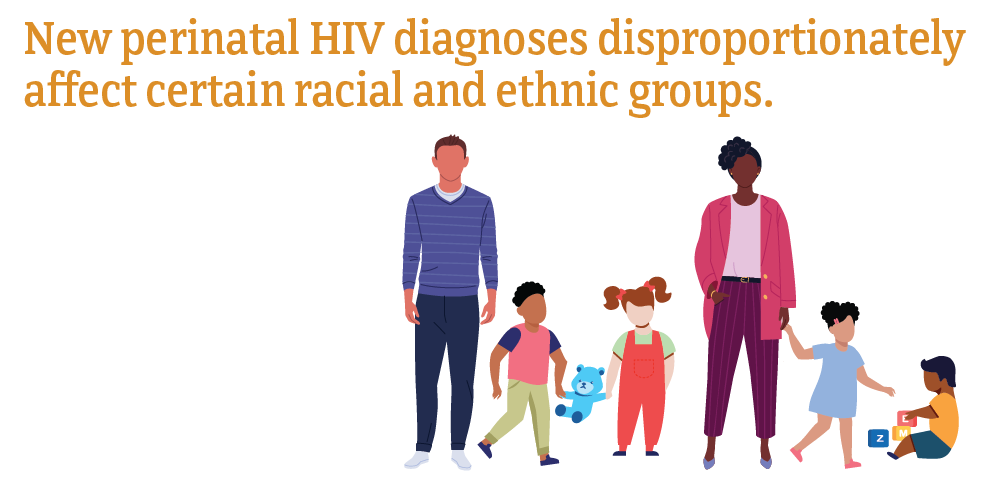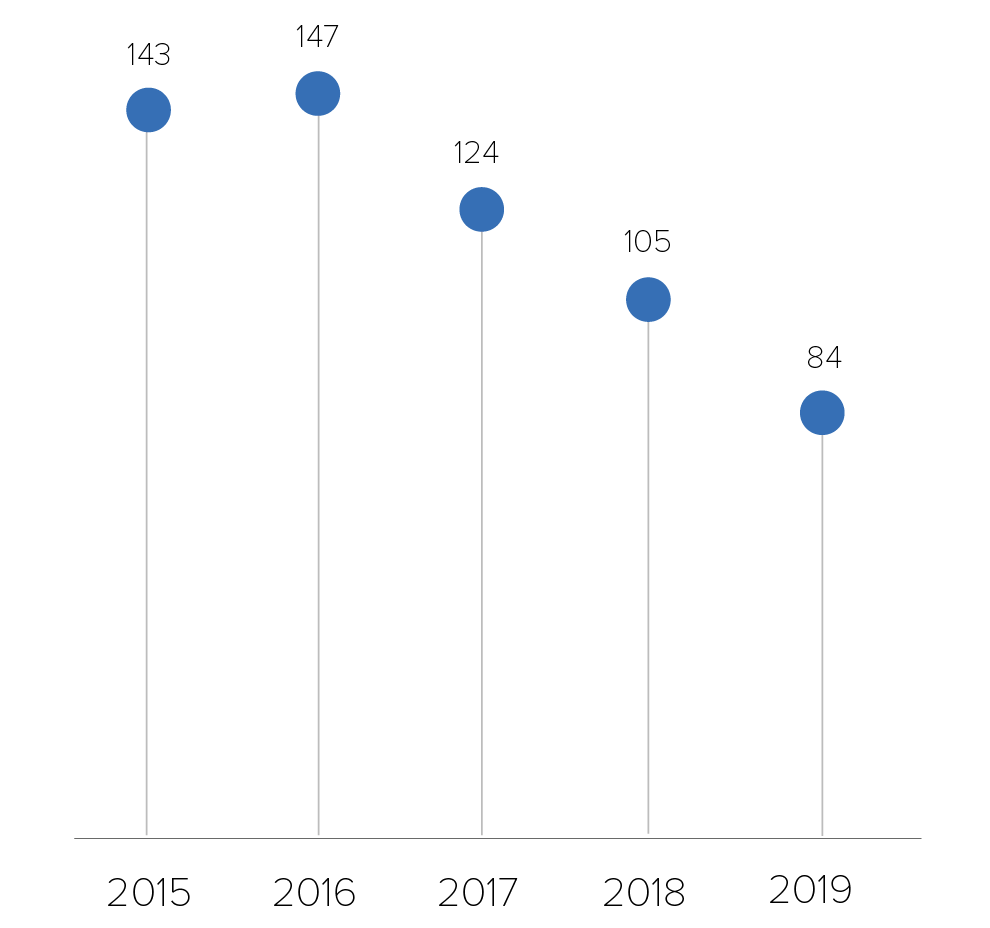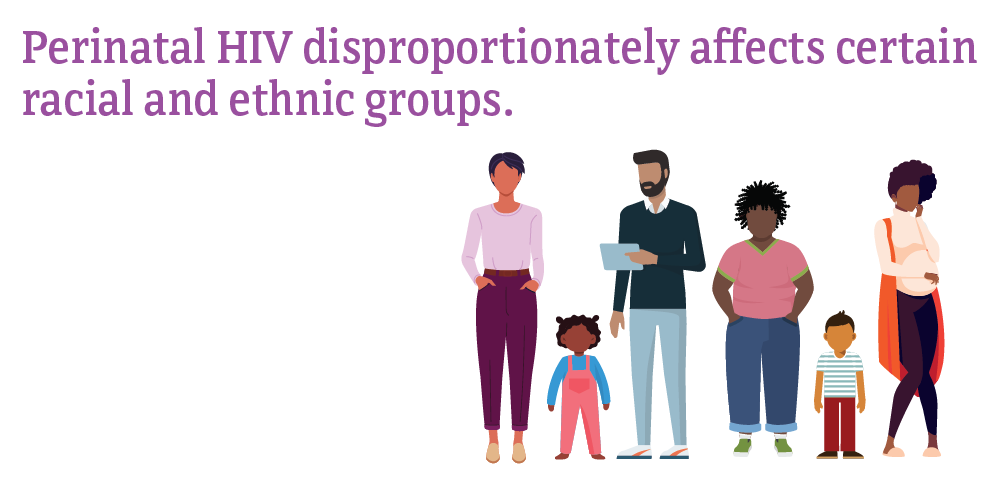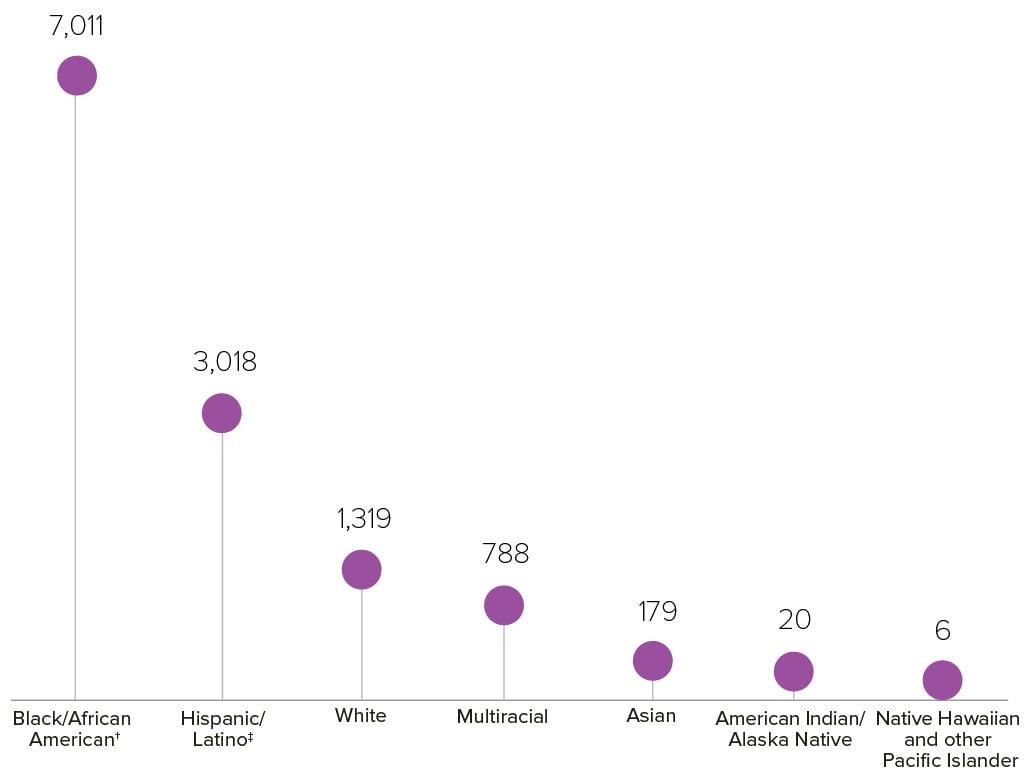HIV and Perinatal Transmission: The Numbers
Most people with HIV who give birth in the US do not transmit HIV to their babies. We don’t know exactly how many people with HIV give birth annually in the United States. Data suggest that the number is less than 5,000.

*Includes HIV diagnoses attributed to perinatal transmission among adults, adolescents, and children.


* In 2019, there were no cases of perinatal HIV among Native Hawaiian and other Pacific Islander people.
† Includes HIV diagnoses attributed to perinatal transmission among adults, adolescents, and children. Data have been statistically adjusted to account for missing transmission category.
‡ Black refers to people having origins in any of the Black racial groups of Africa. African American is a term often used for people of African descent with ancestry in North America.
** Hispanic/Latino people can be of any race.
Source: CDC. Diagnoses of HIV infection in the United States and dependent areas, 2019. HIV Surveillance Report 2021;32.


*Includes HIV diagnoses attributed to perinatal transmission among adults, adolescents, and children.
Source: CDC. Diagnoses of HIV infection in the United States and dependent areas, 2019. HIV Surveillance Report 2021;32.



*Includes adults, adolescents, and children under the age of 13.
†Black refers to people having origins in any of the Black racial groups of Africa. African American is a term often used for people of African descent with ancestry in North America.
‡Hispanic/Latino people can be of any race.
Source: CDC. Diagnoses of HIV infection in the United States and dependent areas, 2019. HIV Surveillance Report 2021;32.
Web Sites
- HHS Panel on Treatment of HIV During Pregnancy and Prevention of Perinatal Transmission
- National Women and Girls HIV Awareness Day
- Mother-to-Child Transmission Resources (AIDS Education and Training Centers)
- STDs and Pregnancy
- HIV and AIDS (womenshealth.gov)
- Pregnancy and HIV, Viral Hepatitis, STD, and TB Prevention
- Breastfeeding and HIV
General Resources
- CDC-INFO 1-800-CDC-INFO (232-4636)
- CDC HIV Website
- CDC Let’s Stop HIV Together Campaign
- CDC HIV Risk Reduction Tool
- Find Testing Sites Near You
- CDC. Diagnoses of HIV infection in the United States and dependent areas, 2019. HIV Surveillance Report 2021;32.
- CDC. Monitoring selected national HIV prevention and care objectives by using HIV surveillance data—United States and 6 dependent areas, 2018. HIV Surveillance Supplemental Report 2020;25(2).
- Nesheim SR, FitzHarris LF, Lampe MA, et al. Reconsidering the number of women with HIV infection who give birth annually in the United States. Public Health Rep 2018;133(6):637-43. PubMed abstract.
- Little KM, Taylor AW, Borkowf CB, et al. Perinatal antiretroviral exposure and prevented mother-to-child HIV infections in the era of antiretroviral prophylaxis in the United States, 1994-2010. Pediatr Infect Dis J 2017;36(1):66-71. PubMed abstract.
- Panel on Treatment of HIV During Pregnancy and Prevention of Perinatal Transmission. Recommendations for use of antiretroviral drugs during pregnancy and interventions to reduce perinatal HIV transmission in the Unites States.
- Townsend CL, Cortina-Borja M, Peckham CS, et al. Low rates of mother-to-child transmission of HIV following effective pregnancy interventions in the United Kingdom and Ireland, 2000–2006. AIDS 2008;22(8):973-81. PubMed abstract.
- CDC. Achievements in public health: reduction in perinatal transmission of HIV infection—United States, 1985–2005. MMWR 2006;55(21):592-7.
- Fleming PL, Lindegren ML, Byers R, et al. Estimated number of perinatal HIV infections, U.S., 2000. Poster presented at: XIV International AIDS Conference; July 7-12, 2002; Barcelona, Italy.
- Whitmore SK, Zhang X, Taylor AW, et al. Estimated number of infants born to HIV-infected women in the United States and five dependent areas, 2006. J Acquir Immune Defic Syndr 2011;57(3):218-22.
- Valverde E, Short W, Brady K, et al. HIV medical provider’s assessment of the reproductive plans of women receiving HIV care: medical monitoring project provider survey, 2009. Paper presented at: 6th International AIDS Society Conference on HIV Pathogenesis, Treatment and Prevention; July 17-20, 2011; Rome, Italy.
- Whitmore SW, Taylor AW, Espinoza L, et al. Correlates of mother-to-child HIV transmission in the United States and Puerto Rico. Pediatrics 2012;129(1):74-81.
- Taylor AW, Nesheim S, Whitmore S, et al. Estimated number and characteristics associated with perinatal HIV infections, 33 states, United States, 2003–2007. Paper presented at: 6th International AIDS Society Conference on HIV Pathogenesis, Treatment and Prevention. July 17-20, 2011; Rome, Italy.
- Branson B, Handsfield HH, Lampe MA, et al. Revised recommendations for HIV testing of adults, adolescents, and pregnant women in health-care settings. MMWR 2006;55(RR-14):1-17.
- Barrow RY, Newman LM, Douglas JM Jr. Taking positive steps to address STD disparities for African American communities. Sex Transm Dis 2008;35(12 Suppl):S1-S3.
- Gaur AH, Dominguez KL, Kalish ML, et al. Practice of feeding premasticated food to infants: a potential risk factor for HIV transmission. Pediatrics 2009;124(2):658-66.
- Lampe MA, Smith DK, Anderson GJ, Edwards AE, Nesheim SR. Achieving safe conception in HIV-discordant couples: the potential role of oral preexposure prophylaxis (PrEP) in the United States. Am J Obstet Gynecol 2011;204(6):488.e1-8.
- Luzuriaga K, Tabak B, Garber M, et al. HIV type 1 (HIV-1) proviral reservoirs decay continuously under sustained virologic control in HIV-1–infected children who received early treatment. J Infect Dis 2014;210(10);1529-38.
- Nesheim SR, Wiener J, FitzHarris L, et al. Brief report: estimated incidence of perinatally acquired HIV infection in the United States, 1978–2013; J Acquir Immune Defic Syndr 2017;76:461-4.